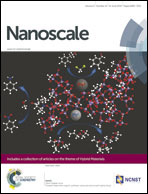The structural transitions of C60 nanowhiskers under an electric field characterized by in situ transmission electron microscopy and electron energy-loss spectroscopy
Abstract
In situ electrical transport measurements for individual C60 nanowhiskers are performed using a transmission electron microscope which monitors the crystal and electronic structural changes of the C60 nanowhiskers simultaneously. Electron diffraction combined with electron energy-loss spectroscopy shows that under the external electric current, the C60 nanowhiskers first transform from a face-centered-cubic structure to a disordered arrangement of C60 molecules. The cage structure of the C60 molecules then collapses to an amorphous carbon and finally, the amorphous carbon turns into graphene stacks. This process indicates the hybridization transformation from sp2.278 to sp2, which is different from the transition process of C60 materials under high pressure. The obtained results also suggest that the stability of the C60 nanowhiskers should be of crucial concern when they work as electrical devices.


 Please wait while we load your content...
Please wait while we load your content...